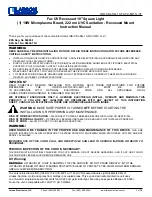
manufactured using doped fused quartz (can produce 185 nm ozone) or soda-lime glass (cannot
produce 185 nm ozone) so that UV 254 nm bands from the mercury arc can pass through the
material. Quartz-based UV-C lights increase electrical efficiency and require a short warm-up
time of 30 seconds to reach full output. This type of 254 nm fluorescent light source typically
overheats in environments above 40°C. At this temperature, UV-C output decreases. T5 or T6
high-output quartz UV lamps can be used for areas requiring intense disinfection. This
alternative provides up to 2 times more output compared to legacy quartz UV-C lights. UV
fluorescent units rely on mercury to produce illumination, via two electrodes. Induction lights
that offer UV 254 nm do not contain electrodes, resulting in a longer lifespan and increased
reliability. The units are well sealed and energy efficient.
5.2 Safety Considerations
UV-C 254 nm light is a powerful solution against disease-causing microorganisms. For humans,
exposure to this range of UV light is harmful. Direct exposure can lead to skin burns and
damage the cornea. Human cells attempt to repair DNA damage when exposed to UV-C 254
nm. Failure to repair the damage can result in tumor growth. Unlike standard (non-UV)
illumination, looking at UV lamps does not cause a natural squinting reaction. In some cases,
the negative effects of UV exposure are delayed by more than six hours. As a safety precaution
when sanitizing rooms, humans should not be present in the area during the process. Operators
may setup temporary signs around the space to ensure people are aware of ongoing sanitation
and avoid exposure. Exposure to chemicals, such as mercury, xenon and argon, is a possibility
should the lamp or bulb shatter during use. Moreover, due to the presence of toxic chemicals,
the lamp must be properly disposed at the end of its lifecycle.
5.3 Germicidal Effectiveness
A 2020 study
11
provides a comprehensive overview of the germicidal effectiveness of 254 nm
UV light. The researchers from the study applied a mercury vapor lamp with a UV 254 nm band
to the following types of microbes (on nitrocellulose filter papers):
•
Escherichia coli ATCC25922 (
E. coli)
•
Extended Spectrum Beta-Lactamase-producing
E. coli
(ESBL)
•
MRSA
•
Mycobacterium tuberculosis
(MTB)
•
Influenza A Viruses H1N1 and H3N2
The results showed successful elimination at a rate of 3-log
10
inactivation for bacteria, 4-log
10
inactivation for viruses and 5-log
10
inactivation for MTB. It took between 10 to 30 minutes of
exposure to achieve such levels of inactivation during the tests.
In another 2020 study
12
, recommendations to use germicidal UV light to prevent “viral
replication” of SARS
-COV-2 and improve lung capabilities for patients were issued. Researchers

































